Business Report: Manage Knowledge and Information - Assessment 1 & 2
VerifiedAdded on 2023/01/06
|26
|6677
|89
Report
AI Summary
This report presents a thorough analysis of knowledge and information management within a business context, encompassing two assessments and a comprehensive business report. Assessment 1 delves into technology, analysis methods, Management Information Systems (MIS), and Decision Support Systems (DSS), exploring their applications and implications in a business setting. Assessment 2 involves compiling a business report, including data review, performance analysis of coffee stores, root cause analysis, and conditional means analysis. The report also addresses business decision-making based on data, risk management, and the development of a system for information and knowledge management, including a decision support tool and system components. This report provides insights into effective strategies for managing and leveraging knowledge and information to enhance business performance and decision-making processes. This report provides an in-depth analysis of managing knowledge and information, including assessments, business reports, data analysis, and decision-making strategies.
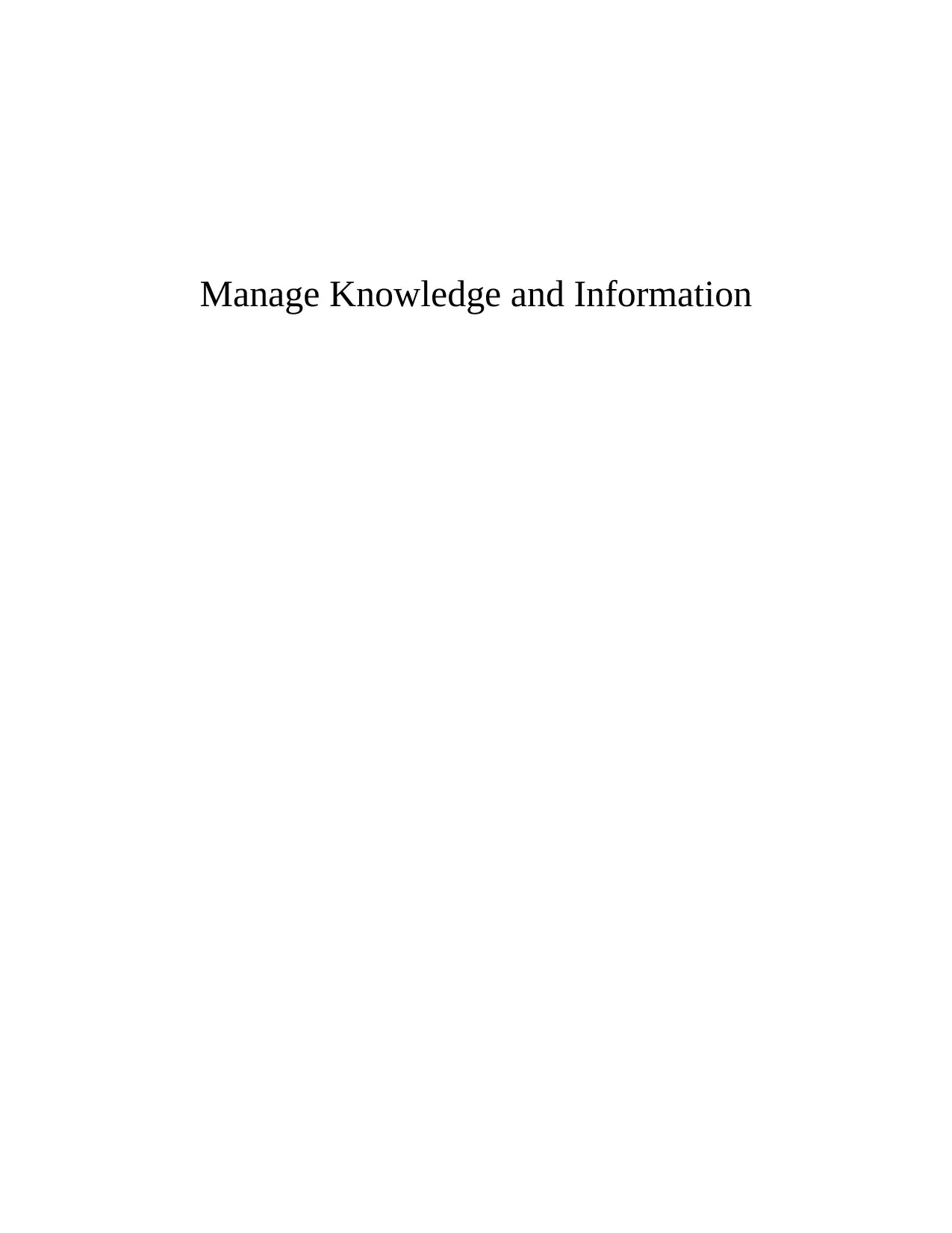
Manage Knowledge and Information
Paraphrase This Document
Need a fresh take? Get an instant paraphrase of this document with our AI Paraphraser
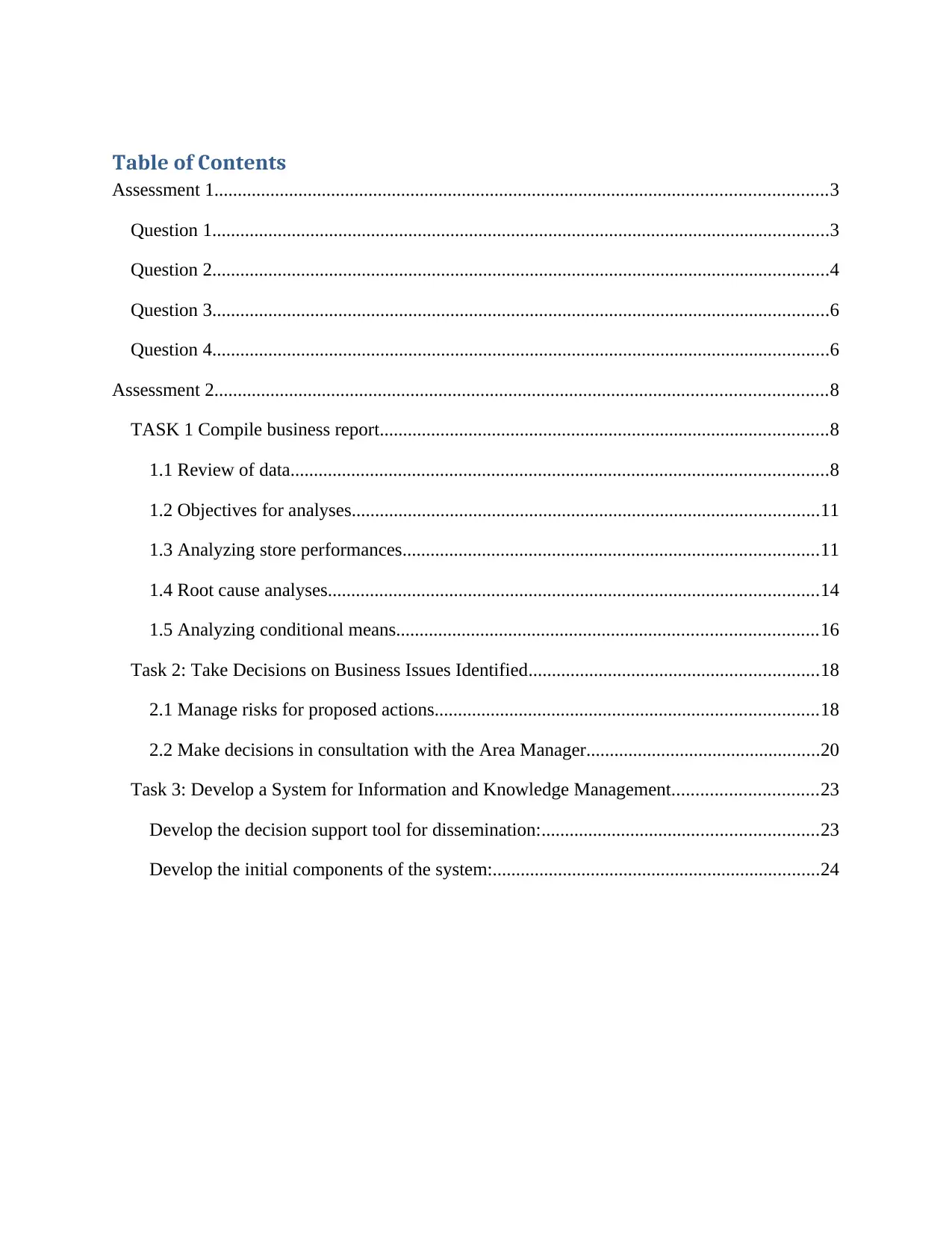
Table of Contents
Assessment 1...................................................................................................................................3
Question 1....................................................................................................................................3
Question 2....................................................................................................................................4
Question 3....................................................................................................................................6
Question 4....................................................................................................................................6
Assessment 2...................................................................................................................................8
TASK 1 Compile business report................................................................................................8
1.1 Review of data...................................................................................................................8
1.2 Objectives for analyses....................................................................................................11
1.3 Analyzing store performances.........................................................................................11
1.4 Root cause analyses.........................................................................................................14
1.5 Analyzing conditional means..........................................................................................16
Task 2: Take Decisions on Business Issues Identified..............................................................18
2.1 Manage risks for proposed actions..................................................................................18
2.2 Make decisions in consultation with the Area Manager..................................................20
Task 3: Develop a System for Information and Knowledge Management...............................23
Develop the decision support tool for dissemination:...........................................................23
Develop the initial components of the system:......................................................................24
Assessment 1...................................................................................................................................3
Question 1....................................................................................................................................3
Question 2....................................................................................................................................4
Question 3....................................................................................................................................6
Question 4....................................................................................................................................6
Assessment 2...................................................................................................................................8
TASK 1 Compile business report................................................................................................8
1.1 Review of data...................................................................................................................8
1.2 Objectives for analyses....................................................................................................11
1.3 Analyzing store performances.........................................................................................11
1.4 Root cause analyses.........................................................................................................14
1.5 Analyzing conditional means..........................................................................................16
Task 2: Take Decisions on Business Issues Identified..............................................................18
2.1 Manage risks for proposed actions..................................................................................18
2.2 Make decisions in consultation with the Area Manager..................................................20
Task 3: Develop a System for Information and Knowledge Management...............................23
Develop the decision support tool for dissemination:...........................................................23
Develop the initial components of the system:......................................................................24
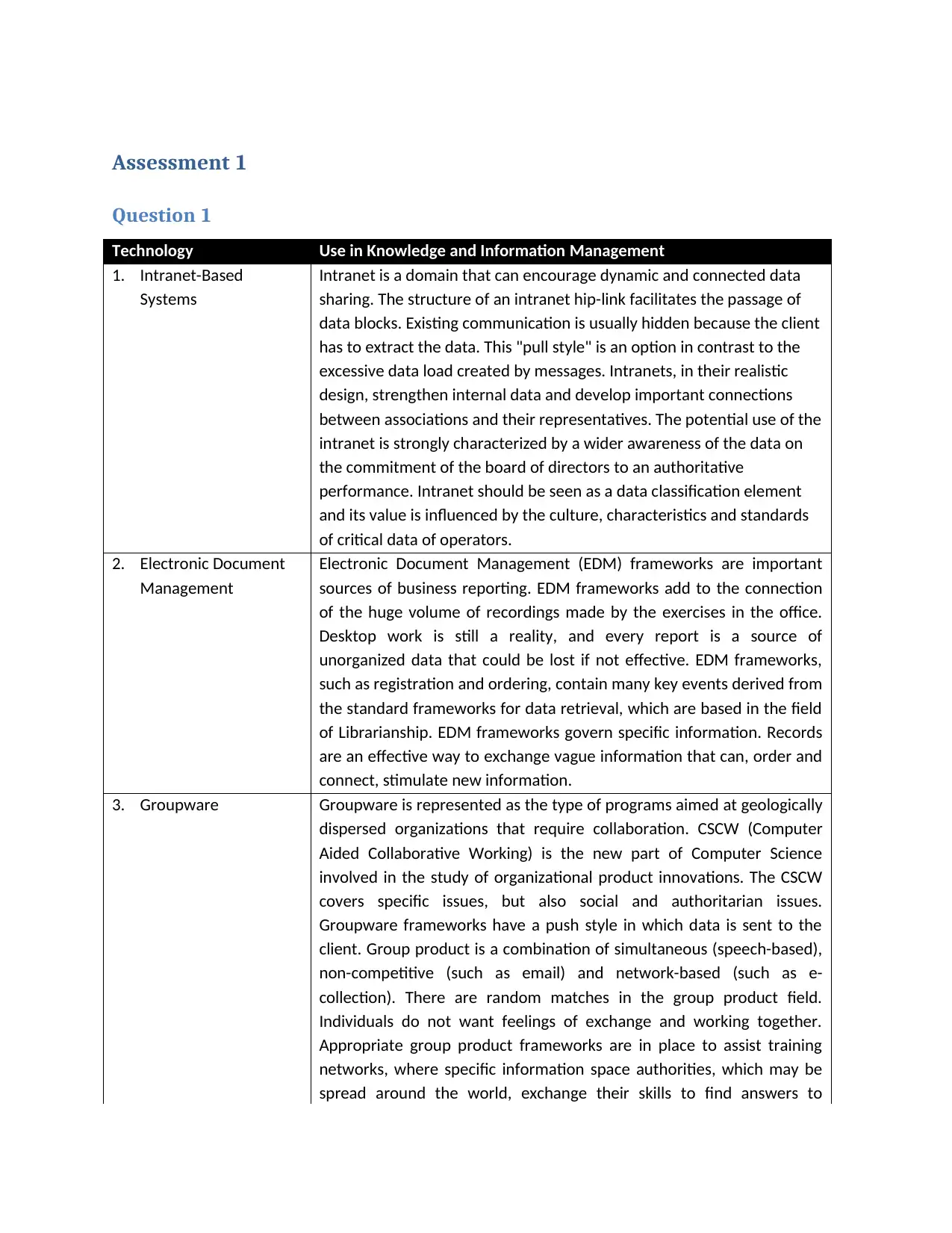
Assessment 1
Question 1
Technology Use in Knowledge and Information Management
1. Intranet-Based
Systems
Intranet is a domain that can encourage dynamic and connected data
sharing. The structure of an intranet hip-link facilitates the passage of
data blocks. Existing communication is usually hidden because the client
has to extract the data. This "pull style" is an option in contrast to the
excessive data load created by messages. Intranets, in their realistic
design, strengthen internal data and develop important connections
between associations and their representatives. The potential use of the
intranet is strongly characterized by a wider awareness of the data on
the commitment of the board of directors to an authoritative
performance. Intranet should be seen as a data classification element
and its value is influenced by the culture, characteristics and standards
of critical data of operators.
2. Electronic Document
Management
Electronic Document Management (EDM) frameworks are important
sources of business reporting. EDM frameworks add to the connection
of the huge volume of recordings made by the exercises in the office.
Desktop work is still a reality, and every report is a source of
unorganized data that could be lost if not effective. EDM frameworks,
such as registration and ordering, contain many key events derived from
the standard frameworks for data retrieval, which are based in the field
of Librarianship. EDM frameworks govern specific information. Records
are an effective way to exchange vague information that can, order and
connect, stimulate new information.
3. Groupware Groupware is represented as the type of programs aimed at geologically
dispersed organizations that require collaboration. CSCW (Computer
Aided Collaborative Working) is the new part of Computer Science
involved in the study of organizational product innovations. The CSCW
covers specific issues, but also social and authoritarian issues.
Groupware frameworks have a push style in which data is sent to the
client. Group product is a combination of simultaneous (speech-based),
non-competitive (such as email) and network-based (such as e-
collection). There are random matches in the group product field.
Individuals do not want feelings of exchange and working together.
Appropriate group product frameworks are in place to assist training
networks, where specific information space authorities, which may be
spread around the world, exchange their skills to find answers to
Question 1
Technology Use in Knowledge and Information Management
1. Intranet-Based
Systems
Intranet is a domain that can encourage dynamic and connected data
sharing. The structure of an intranet hip-link facilitates the passage of
data blocks. Existing communication is usually hidden because the client
has to extract the data. This "pull style" is an option in contrast to the
excessive data load created by messages. Intranets, in their realistic
design, strengthen internal data and develop important connections
between associations and their representatives. The potential use of the
intranet is strongly characterized by a wider awareness of the data on
the commitment of the board of directors to an authoritative
performance. Intranet should be seen as a data classification element
and its value is influenced by the culture, characteristics and standards
of critical data of operators.
2. Electronic Document
Management
Electronic Document Management (EDM) frameworks are important
sources of business reporting. EDM frameworks add to the connection
of the huge volume of recordings made by the exercises in the office.
Desktop work is still a reality, and every report is a source of
unorganized data that could be lost if not effective. EDM frameworks,
such as registration and ordering, contain many key events derived from
the standard frameworks for data retrieval, which are based in the field
of Librarianship. EDM frameworks govern specific information. Records
are an effective way to exchange vague information that can, order and
connect, stimulate new information.
3. Groupware Groupware is represented as the type of programs aimed at geologically
dispersed organizations that require collaboration. CSCW (Computer
Aided Collaborative Working) is the new part of Computer Science
involved in the study of organizational product innovations. The CSCW
covers specific issues, but also social and authoritarian issues.
Groupware frameworks have a push style in which data is sent to the
client. Group product is a combination of simultaneous (speech-based),
non-competitive (such as email) and network-based (such as e-
collection). There are random matches in the group product field.
Individuals do not want feelings of exchange and working together.
Appropriate group product frameworks are in place to assist training
networks, where specific information space authorities, which may be
spread around the world, exchange their skills to find answers to
⊘ This is a preview!⊘
Do you want full access?
Subscribe today to unlock all pages.

Trusted by 1+ million students worldwide
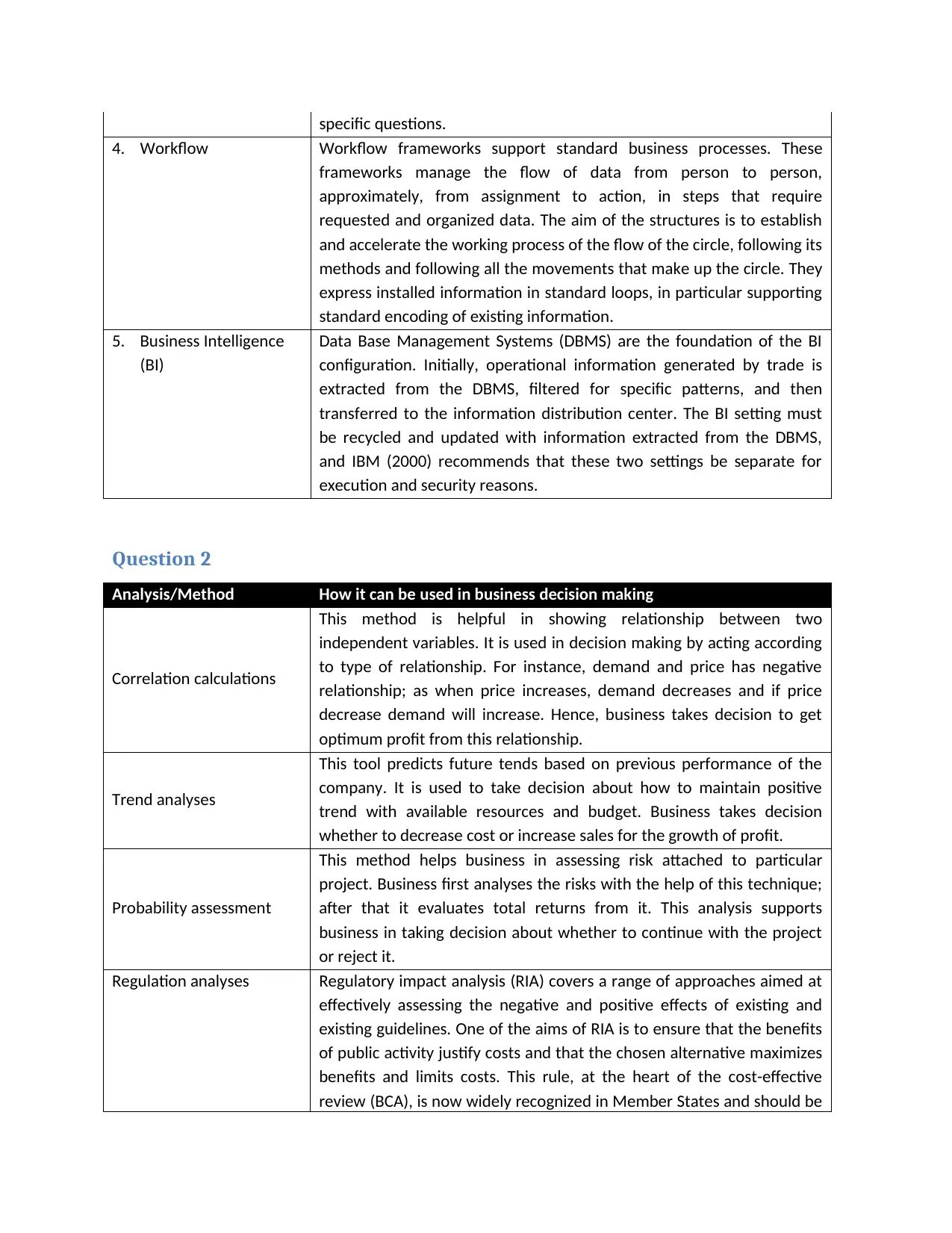
specific questions.
4. Workflow Workflow frameworks support standard business processes. These
frameworks manage the flow of data from person to person,
approximately, from assignment to action, in steps that require
requested and organized data. The aim of the structures is to establish
and accelerate the working process of the flow of the circle, following its
methods and following all the movements that make up the circle. They
express installed information in standard loops, in particular supporting
standard encoding of existing information.
5. Business Intelligence
(BI)
Data Base Management Systems (DBMS) are the foundation of the BI
configuration. Initially, operational information generated by trade is
extracted from the DBMS, filtered for specific patterns, and then
transferred to the information distribution center. The BI setting must
be recycled and updated with information extracted from the DBMS,
and IBM (2000) recommends that these two settings be separate for
execution and security reasons.
Question 2
Analysis/Method How it can be used in business decision making
Correlation calculations
This method is helpful in showing relationship between two
independent variables. It is used in decision making by acting according
to type of relationship. For instance, demand and price has negative
relationship; as when price increases, demand decreases and if price
decrease demand will increase. Hence, business takes decision to get
optimum profit from this relationship.
Trend analyses
This tool predicts future tends based on previous performance of the
company. It is used to take decision about how to maintain positive
trend with available resources and budget. Business takes decision
whether to decrease cost or increase sales for the growth of profit.
Probability assessment
This method helps business in assessing risk attached to particular
project. Business first analyses the risks with the help of this technique;
after that it evaluates total returns from it. This analysis supports
business in taking decision about whether to continue with the project
or reject it.
Regulation analyses Regulatory impact analysis (RIA) covers a range of approaches aimed at
effectively assessing the negative and positive effects of existing and
existing guidelines. One of the aims of RIA is to ensure that the benefits
of public activity justify costs and that the chosen alternative maximizes
benefits and limits costs. This rule, at the heart of the cost-effective
review (BCA), is now widely recognized in Member States and should be
4. Workflow Workflow frameworks support standard business processes. These
frameworks manage the flow of data from person to person,
approximately, from assignment to action, in steps that require
requested and organized data. The aim of the structures is to establish
and accelerate the working process of the flow of the circle, following its
methods and following all the movements that make up the circle. They
express installed information in standard loops, in particular supporting
standard encoding of existing information.
5. Business Intelligence
(BI)
Data Base Management Systems (DBMS) are the foundation of the BI
configuration. Initially, operational information generated by trade is
extracted from the DBMS, filtered for specific patterns, and then
transferred to the information distribution center. The BI setting must
be recycled and updated with information extracted from the DBMS,
and IBM (2000) recommends that these two settings be separate for
execution and security reasons.
Question 2
Analysis/Method How it can be used in business decision making
Correlation calculations
This method is helpful in showing relationship between two
independent variables. It is used in decision making by acting according
to type of relationship. For instance, demand and price has negative
relationship; as when price increases, demand decreases and if price
decrease demand will increase. Hence, business takes decision to get
optimum profit from this relationship.
Trend analyses
This tool predicts future tends based on previous performance of the
company. It is used to take decision about how to maintain positive
trend with available resources and budget. Business takes decision
whether to decrease cost or increase sales for the growth of profit.
Probability assessment
This method helps business in assessing risk attached to particular
project. Business first analyses the risks with the help of this technique;
after that it evaluates total returns from it. This analysis supports
business in taking decision about whether to continue with the project
or reject it.
Regulation analyses Regulatory impact analysis (RIA) covers a range of approaches aimed at
effectively assessing the negative and positive effects of existing and
existing guidelines. One of the aims of RIA is to ensure that the benefits
of public activity justify costs and that the chosen alternative maximizes
benefits and limits costs. This rule, at the heart of the cost-effective
review (BCA), is now widely recognized in Member States and should be
Paraphrase This Document
Need a fresh take? Get an instant paraphrase of this document with our AI Paraphraser
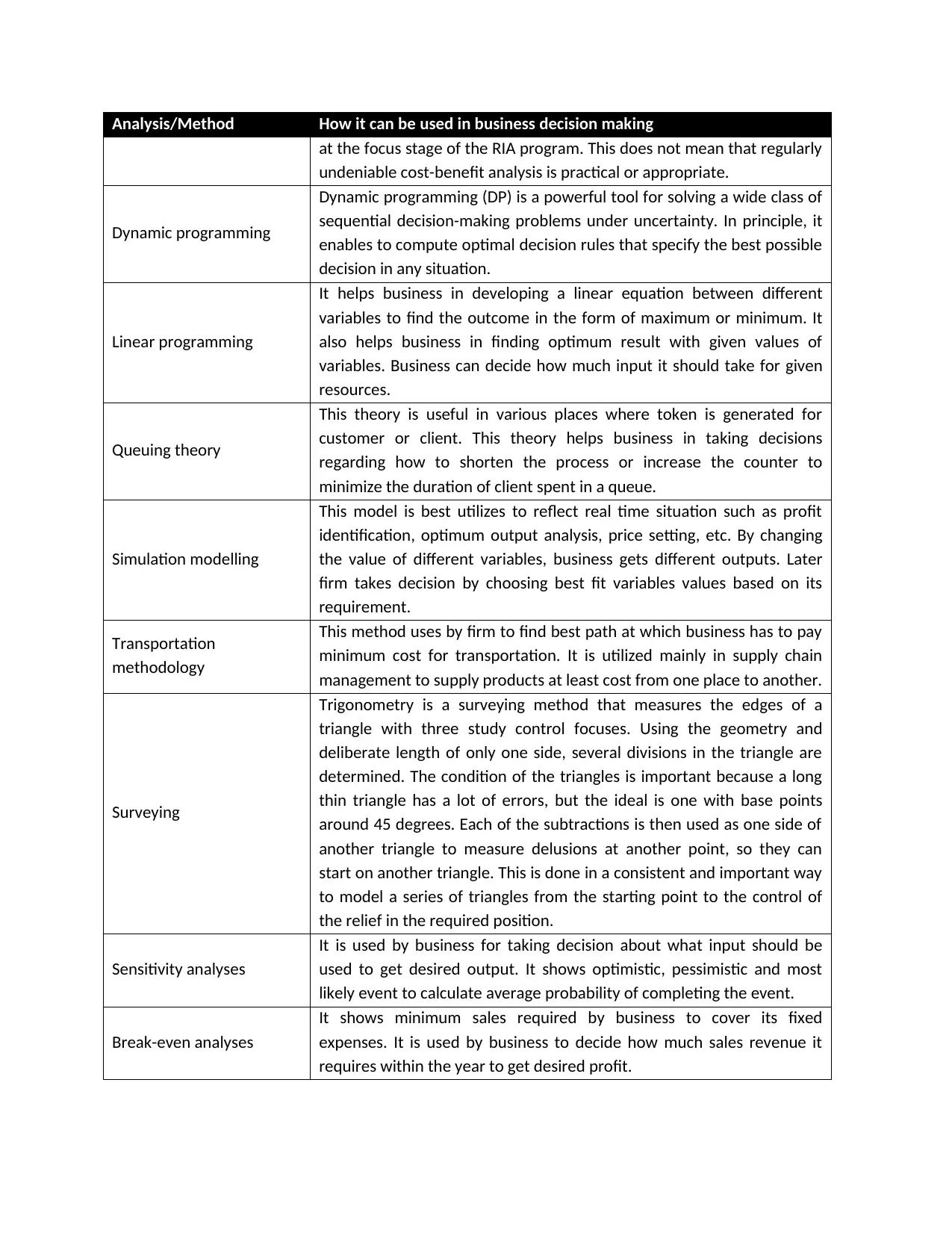
Analysis/Method How it can be used in business decision making
at the focus stage of the RIA program. This does not mean that regularly
undeniable cost-benefit analysis is practical or appropriate.
Dynamic programming
Dynamic programming (DP) is a powerful tool for solving a wide class of
sequential decision-making problems under uncertainty. In principle, it
enables to compute optimal decision rules that specify the best possible
decision in any situation.
Linear programming
It helps business in developing a linear equation between different
variables to find the outcome in the form of maximum or minimum. It
also helps business in finding optimum result with given values of
variables. Business can decide how much input it should take for given
resources.
Queuing theory
This theory is useful in various places where token is generated for
customer or client. This theory helps business in taking decisions
regarding how to shorten the process or increase the counter to
minimize the duration of client spent in a queue.
Simulation modelling
This model is best utilizes to reflect real time situation such as profit
identification, optimum output analysis, price setting, etc. By changing
the value of different variables, business gets different outputs. Later
firm takes decision by choosing best fit variables values based on its
requirement.
Transportation
methodology
This method uses by firm to find best path at which business has to pay
minimum cost for transportation. It is utilized mainly in supply chain
management to supply products at least cost from one place to another.
Surveying
Trigonometry is a surveying method that measures the edges of a
triangle with three study control focuses. Using the geometry and
deliberate length of only one side, several divisions in the triangle are
determined. The condition of the triangles is important because a long
thin triangle has a lot of errors, but the ideal is one with base points
around 45 degrees. Each of the subtractions is then used as one side of
another triangle to measure delusions at another point, so they can
start on another triangle. This is done in a consistent and important way
to model a series of triangles from the starting point to the control of
the relief in the required position.
Sensitivity analyses
It is used by business for taking decision about what input should be
used to get desired output. It shows optimistic, pessimistic and most
likely event to calculate average probability of completing the event.
Break-even analyses
It shows minimum sales required by business to cover its fixed
expenses. It is used by business to decide how much sales revenue it
requires within the year to get desired profit.
at the focus stage of the RIA program. This does not mean that regularly
undeniable cost-benefit analysis is practical or appropriate.
Dynamic programming
Dynamic programming (DP) is a powerful tool for solving a wide class of
sequential decision-making problems under uncertainty. In principle, it
enables to compute optimal decision rules that specify the best possible
decision in any situation.
Linear programming
It helps business in developing a linear equation between different
variables to find the outcome in the form of maximum or minimum. It
also helps business in finding optimum result with given values of
variables. Business can decide how much input it should take for given
resources.
Queuing theory
This theory is useful in various places where token is generated for
customer or client. This theory helps business in taking decisions
regarding how to shorten the process or increase the counter to
minimize the duration of client spent in a queue.
Simulation modelling
This model is best utilizes to reflect real time situation such as profit
identification, optimum output analysis, price setting, etc. By changing
the value of different variables, business gets different outputs. Later
firm takes decision by choosing best fit variables values based on its
requirement.
Transportation
methodology
This method uses by firm to find best path at which business has to pay
minimum cost for transportation. It is utilized mainly in supply chain
management to supply products at least cost from one place to another.
Surveying
Trigonometry is a surveying method that measures the edges of a
triangle with three study control focuses. Using the geometry and
deliberate length of only one side, several divisions in the triangle are
determined. The condition of the triangles is important because a long
thin triangle has a lot of errors, but the ideal is one with base points
around 45 degrees. Each of the subtractions is then used as one side of
another triangle to measure delusions at another point, so they can
start on another triangle. This is done in a consistent and important way
to model a series of triangles from the starting point to the control of
the relief in the required position.
Sensitivity analyses
It is used by business for taking decision about what input should be
used to get desired output. It shows optimistic, pessimistic and most
likely event to calculate average probability of completing the event.
Break-even analyses
It shows minimum sales required by business to cover its fixed
expenses. It is used by business to decide how much sales revenue it
requires within the year to get desired profit.
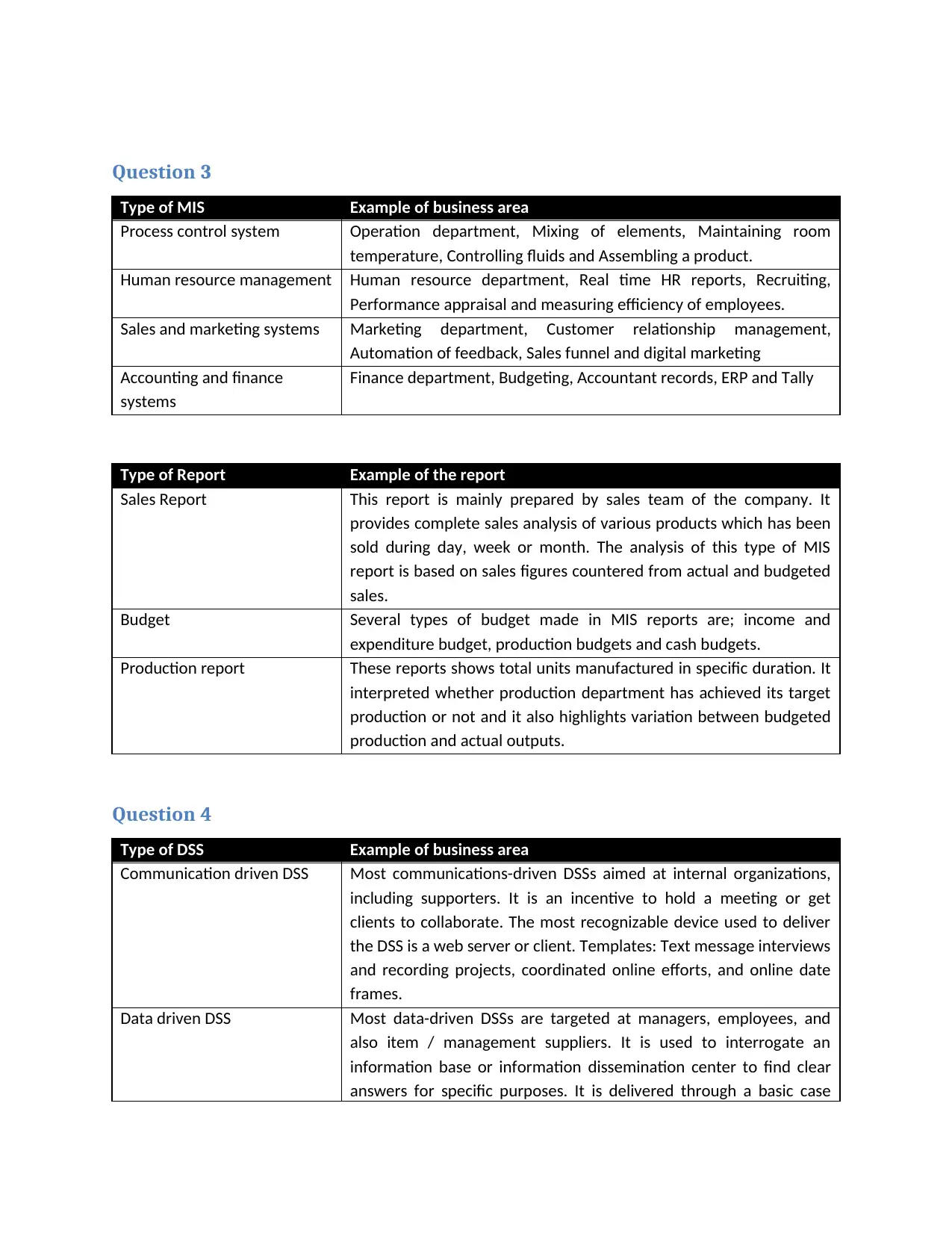
Question 3
Type of MIS Example of business area
Process control system Operation department, Mixing of elements, Maintaining room
temperature, Controlling fluids and Assembling a product.
Human resource management Human resource department, Real time HR reports, Recruiting,
Performance appraisal and measuring efficiency of employees.
Sales and marketing systems Marketing department, Customer relationship management,
Automation of feedback, Sales funnel and digital marketing
Accounting and finance
systems
Finance department, Budgeting, Accountant records, ERP and Tally
Type of Report Example of the report
Sales Report This report is mainly prepared by sales team of the company. It
provides complete sales analysis of various products which has been
sold during day, week or month. The analysis of this type of MIS
report is based on sales figures countered from actual and budgeted
sales.
Budget Several types of budget made in MIS reports are; income and
expenditure budget, production budgets and cash budgets.
Production report These reports shows total units manufactured in specific duration. It
interpreted whether production department has achieved its target
production or not and it also highlights variation between budgeted
production and actual outputs.
Question 4
Type of DSS Example of business area
Communication driven DSS Most communications-driven DSSs aimed at internal organizations,
including supporters. It is an incentive to hold a meeting or get
clients to collaborate. The most recognizable device used to deliver
the DSS is a web server or client. Templates: Text message interviews
and recording projects, coordinated online efforts, and online date
frames.
Data driven DSS Most data-driven DSSs are targeted at managers, employees, and
also item / management suppliers. It is used to interrogate an
information base or information dissemination center to find clear
answers for specific purposes. It is delivered through a basic case
Type of MIS Example of business area
Process control system Operation department, Mixing of elements, Maintaining room
temperature, Controlling fluids and Assembling a product.
Human resource management Human resource department, Real time HR reports, Recruiting,
Performance appraisal and measuring efficiency of employees.
Sales and marketing systems Marketing department, Customer relationship management,
Automation of feedback, Sales funnel and digital marketing
Accounting and finance
systems
Finance department, Budgeting, Accountant records, ERP and Tally
Type of Report Example of the report
Sales Report This report is mainly prepared by sales team of the company. It
provides complete sales analysis of various products which has been
sold during day, week or month. The analysis of this type of MIS
report is based on sales figures countered from actual and budgeted
sales.
Budget Several types of budget made in MIS reports are; income and
expenditure budget, production budgets and cash budgets.
Production report These reports shows total units manufactured in specific duration. It
interpreted whether production department has achieved its target
production or not and it also highlights variation between budgeted
production and actual outputs.
Question 4
Type of DSS Example of business area
Communication driven DSS Most communications-driven DSSs aimed at internal organizations,
including supporters. It is an incentive to hold a meeting or get
clients to collaborate. The most recognizable device used to deliver
the DSS is a web server or client. Templates: Text message interviews
and recording projects, coordinated online efforts, and online date
frames.
Data driven DSS Most data-driven DSSs are targeted at managers, employees, and
also item / management suppliers. It is used to interrogate an
information base or information dissemination center to find clear
answers for specific purposes. It is delivered through a basic case
⊘ This is a preview!⊘
Do you want full access?
Subscribe today to unlock all pages.

Trusted by 1+ million students worldwide
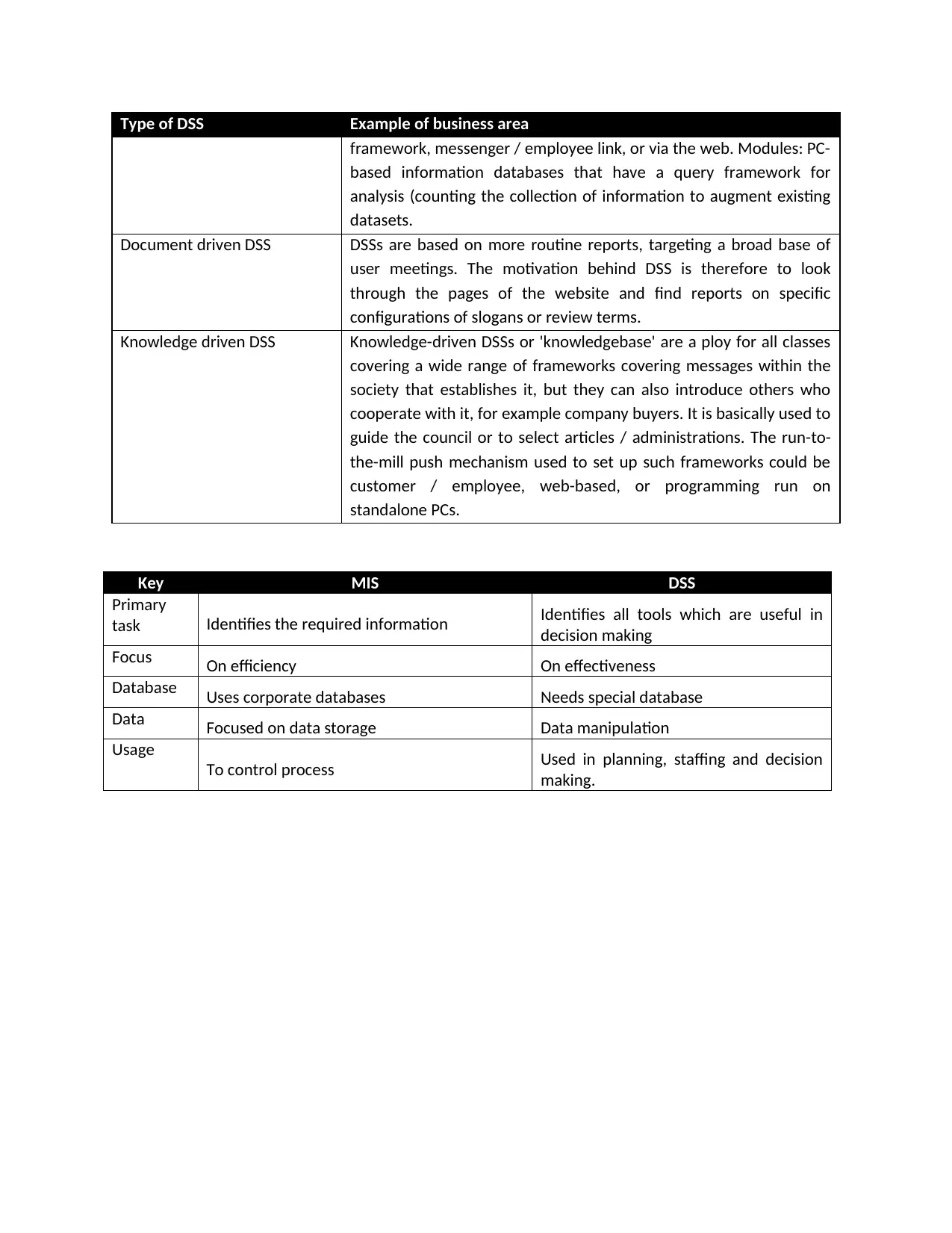
Type of DSS Example of business area
framework, messenger / employee link, or via the web. Modules: PC-
based information databases that have a query framework for
analysis (counting the collection of information to augment existing
datasets.
Document driven DSS DSSs are based on more routine reports, targeting a broad base of
user meetings. The motivation behind DSS is therefore to look
through the pages of the website and find reports on specific
configurations of slogans or review terms.
Knowledge driven DSS Knowledge-driven DSSs or 'knowledgebase' are a ploy for all classes
covering a wide range of frameworks covering messages within the
society that establishes it, but they can also introduce others who
cooperate with it, for example company buyers. It is basically used to
guide the council or to select articles / administrations. The run-to-
the-mill push mechanism used to set up such frameworks could be
customer / employee, web-based, or programming run on
standalone PCs.
Key MIS DSS
Primary
task Identifies the required information Identifies all tools which are useful in
decision making
Focus On efficiency On effectiveness
Database Uses corporate databases Needs special database
Data Focused on data storage Data manipulation
Usage
To control process Used in planning, staffing and decision
making.
framework, messenger / employee link, or via the web. Modules: PC-
based information databases that have a query framework for
analysis (counting the collection of information to augment existing
datasets.
Document driven DSS DSSs are based on more routine reports, targeting a broad base of
user meetings. The motivation behind DSS is therefore to look
through the pages of the website and find reports on specific
configurations of slogans or review terms.
Knowledge driven DSS Knowledge-driven DSSs or 'knowledgebase' are a ploy for all classes
covering a wide range of frameworks covering messages within the
society that establishes it, but they can also introduce others who
cooperate with it, for example company buyers. It is basically used to
guide the council or to select articles / administrations. The run-to-
the-mill push mechanism used to set up such frameworks could be
customer / employee, web-based, or programming run on
standalone PCs.
Key MIS DSS
Primary
task Identifies the required information Identifies all tools which are useful in
decision making
Focus On efficiency On effectiveness
Database Uses corporate databases Needs special database
Data Focused on data storage Data manipulation
Usage
To control process Used in planning, staffing and decision
making.
Paraphrase This Document
Need a fresh take? Get an instant paraphrase of this document with our AI Paraphraser
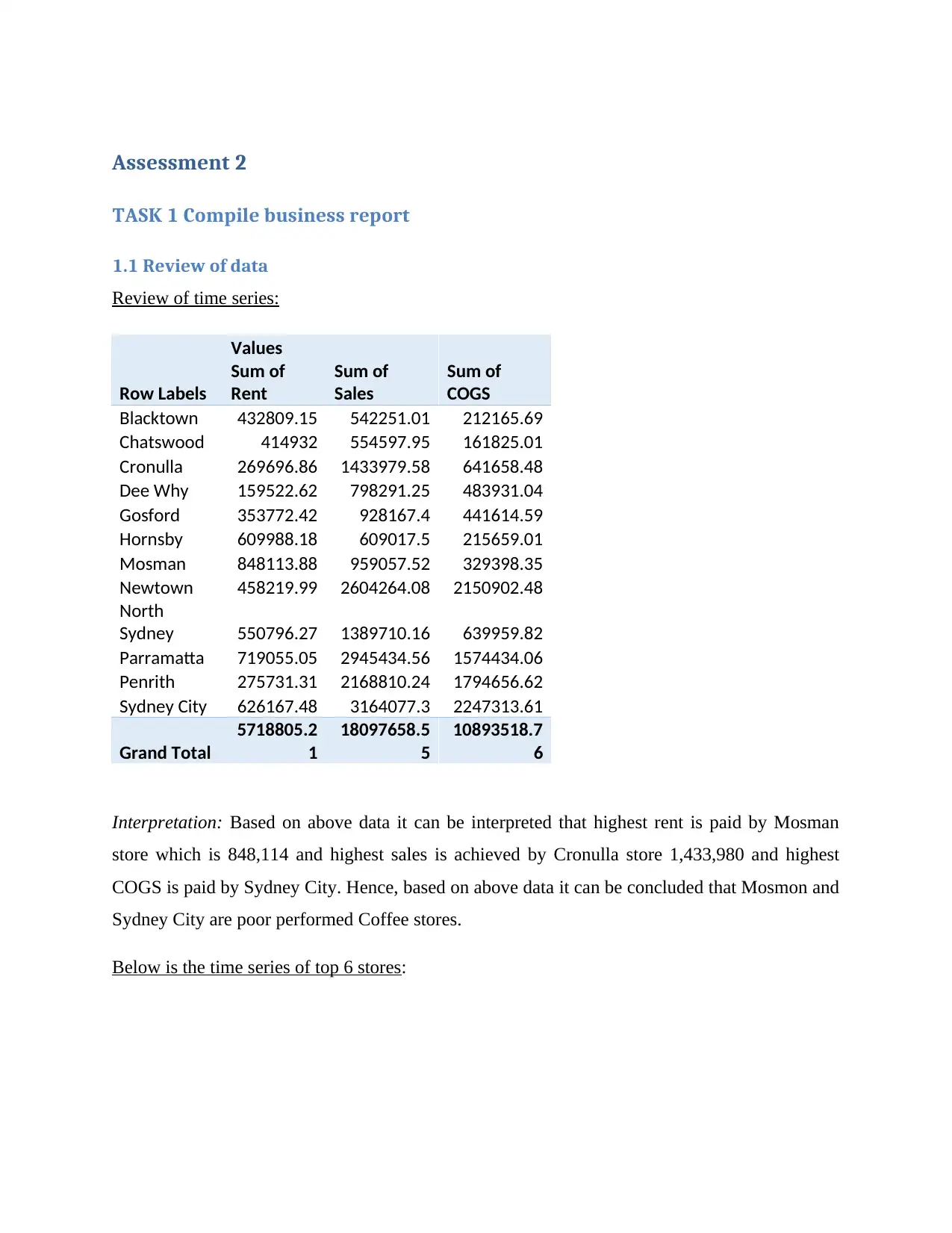
Assessment 2
TASK 1 Compile business report
1.1 Review of data
Review of time series:
Values
Row Labels
Sum of
Rent
Sum of
Sales
Sum of
COGS
Blacktown 432809.15 542251.01 212165.69
Chatswood 414932 554597.95 161825.01
Cronulla 269696.86 1433979.58 641658.48
Dee Why 159522.62 798291.25 483931.04
Gosford 353772.42 928167.4 441614.59
Hornsby 609988.18 609017.5 215659.01
Mosman 848113.88 959057.52 329398.35
Newtown 458219.99 2604264.08 2150902.48
North
Sydney 550796.27 1389710.16 639959.82
Parramatta 719055.05 2945434.56 1574434.06
Penrith 275731.31 2168810.24 1794656.62
Sydney City 626167.48 3164077.3 2247313.61
Grand Total
5718805.2
1
18097658.5
5
10893518.7
6
Interpretation: Based on above data it can be interpreted that highest rent is paid by Mosman
store which is 848,114 and highest sales is achieved by Cronulla store 1,433,980 and highest
COGS is paid by Sydney City. Hence, based on above data it can be concluded that Mosmon and
Sydney City are poor performed Coffee stores.
Below is the time series of top 6 stores:
TASK 1 Compile business report
1.1 Review of data
Review of time series:
Values
Row Labels
Sum of
Rent
Sum of
Sales
Sum of
COGS
Blacktown 432809.15 542251.01 212165.69
Chatswood 414932 554597.95 161825.01
Cronulla 269696.86 1433979.58 641658.48
Dee Why 159522.62 798291.25 483931.04
Gosford 353772.42 928167.4 441614.59
Hornsby 609988.18 609017.5 215659.01
Mosman 848113.88 959057.52 329398.35
Newtown 458219.99 2604264.08 2150902.48
North
Sydney 550796.27 1389710.16 639959.82
Parramatta 719055.05 2945434.56 1574434.06
Penrith 275731.31 2168810.24 1794656.62
Sydney City 626167.48 3164077.3 2247313.61
Grand Total
5718805.2
1
18097658.5
5
10893518.7
6
Interpretation: Based on above data it can be interpreted that highest rent is paid by Mosman
store which is 848,114 and highest sales is achieved by Cronulla store 1,433,980 and highest
COGS is paid by Sydney City. Hence, based on above data it can be concluded that Mosmon and
Sydney City are poor performed Coffee stores.
Below is the time series of top 6 stores:
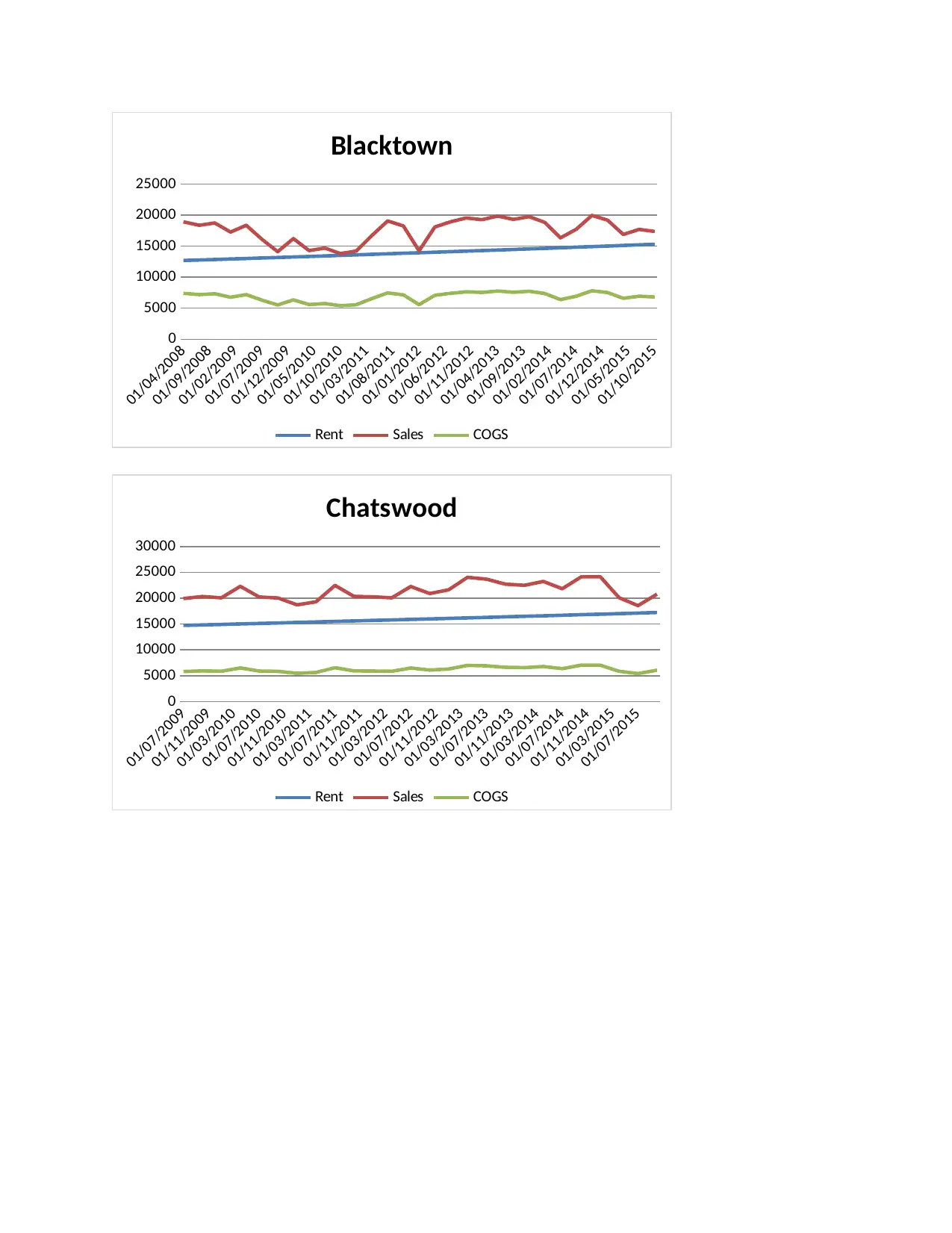
01/04/2008
01/09/2008
01/02/2009
01/07/2009
01/12/2009
01/05/2010
01/10/2010
01/03/2011
01/08/2011
01/01/2012
01/06/2012
01/11/2012
01/04/2013
01/09/2013
01/02/2014
01/07/2014
01/12/2014
01/05/2015
01/10/2015
0
5000
10000
15000
20000
25000
Blacktown
Rent Sales COGS
01/07/2009
01/11/2009
01/03/2010
01/07/2010
01/11/2010
01/03/2011
01/07/2011
01/11/2011
01/03/2012
01/07/2012
01/11/2012
01/03/2013
01/07/2013
01/11/2013
01/03/2014
01/07/2014
01/11/2014
01/03/2015
01/07/2015
0
5000
10000
15000
20000
25000
30000
Chatswood
Rent Sales COGS
01/09/2008
01/02/2009
01/07/2009
01/12/2009
01/05/2010
01/10/2010
01/03/2011
01/08/2011
01/01/2012
01/06/2012
01/11/2012
01/04/2013
01/09/2013
01/02/2014
01/07/2014
01/12/2014
01/05/2015
01/10/2015
0
5000
10000
15000
20000
25000
Blacktown
Rent Sales COGS
01/07/2009
01/11/2009
01/03/2010
01/07/2010
01/11/2010
01/03/2011
01/07/2011
01/11/2011
01/03/2012
01/07/2012
01/11/2012
01/03/2013
01/07/2013
01/11/2013
01/03/2014
01/07/2014
01/11/2014
01/03/2015
01/07/2015
0
5000
10000
15000
20000
25000
30000
Chatswood
Rent Sales COGS
⊘ This is a preview!⊘
Do you want full access?
Subscribe today to unlock all pages.

Trusted by 1+ million students worldwide
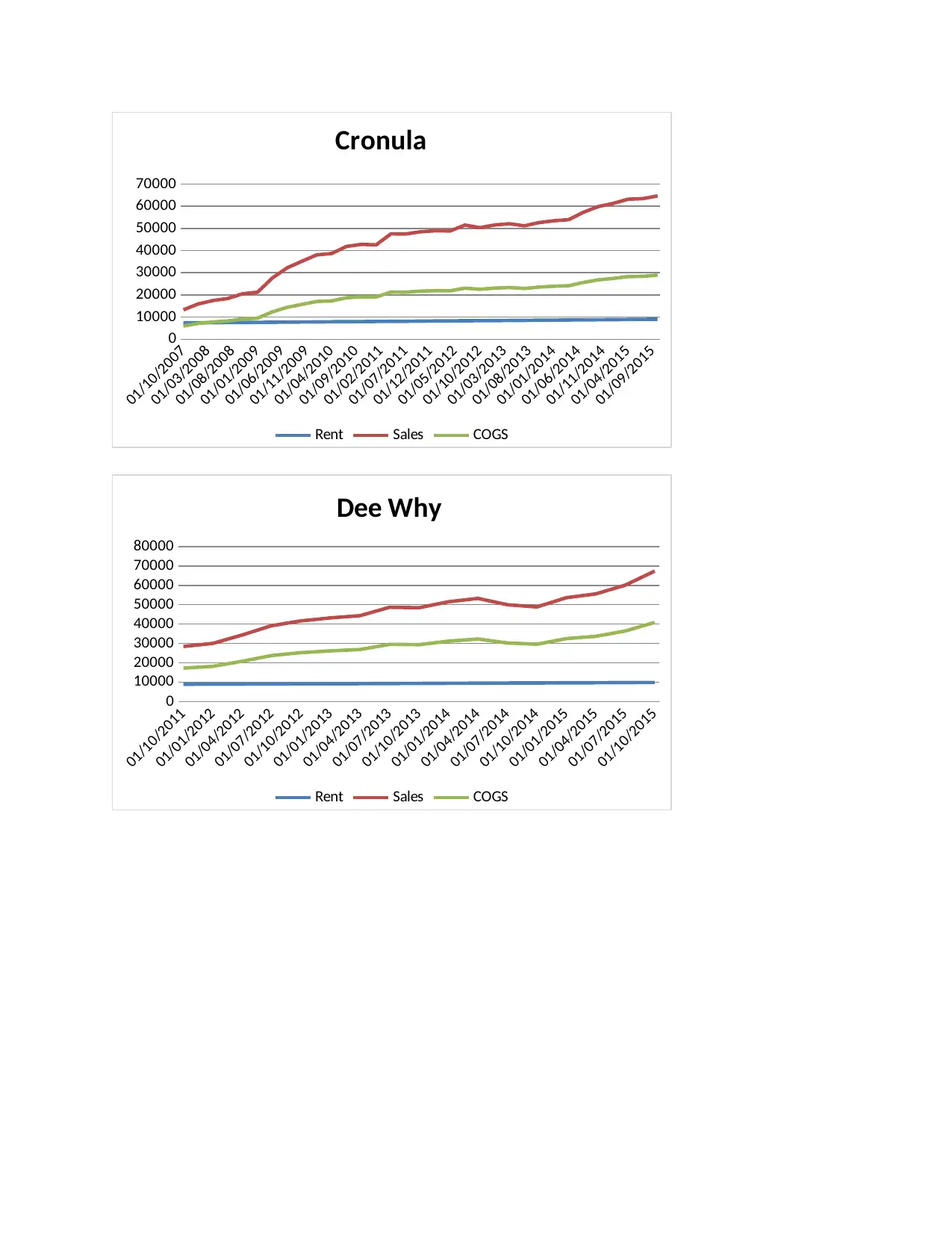
01/10/2007
01/03/2008
01/08/2008
01/01/2009
01/06/2009
01/11/2009
01/04/2010
01/09/2010
01/02/2011
01/07/2011
01/12/2011
01/05/2012
01/10/2012
01/03/2013
01/08/2013
01/01/2014
01/06/2014
01/11/2014
01/04/2015
01/09/2015
0
10000
20000
30000
40000
50000
60000
70000
Cronula
Rent Sales COGS
01/10/2011
01/01/2012
01/04/2012
01/07/2012
01/10/2012
01/01/2013
01/04/2013
01/07/2013
01/10/2013
01/01/2014
01/04/2014
01/07/2014
01/10/2014
01/01/2015
01/04/2015
01/07/2015
01/10/2015
0
10000
20000
30000
40000
50000
60000
70000
80000
Dee Why
Rent Sales COGS
01/03/2008
01/08/2008
01/01/2009
01/06/2009
01/11/2009
01/04/2010
01/09/2010
01/02/2011
01/07/2011
01/12/2011
01/05/2012
01/10/2012
01/03/2013
01/08/2013
01/01/2014
01/06/2014
01/11/2014
01/04/2015
01/09/2015
0
10000
20000
30000
40000
50000
60000
70000
Cronula
Rent Sales COGS
01/10/2011
01/01/2012
01/04/2012
01/07/2012
01/10/2012
01/01/2013
01/04/2013
01/07/2013
01/10/2013
01/01/2014
01/04/2014
01/07/2014
01/10/2014
01/01/2015
01/04/2015
01/07/2015
01/10/2015
0
10000
20000
30000
40000
50000
60000
70000
80000
Dee Why
Rent Sales COGS
Paraphrase This Document
Need a fresh take? Get an instant paraphrase of this document with our AI Paraphraser
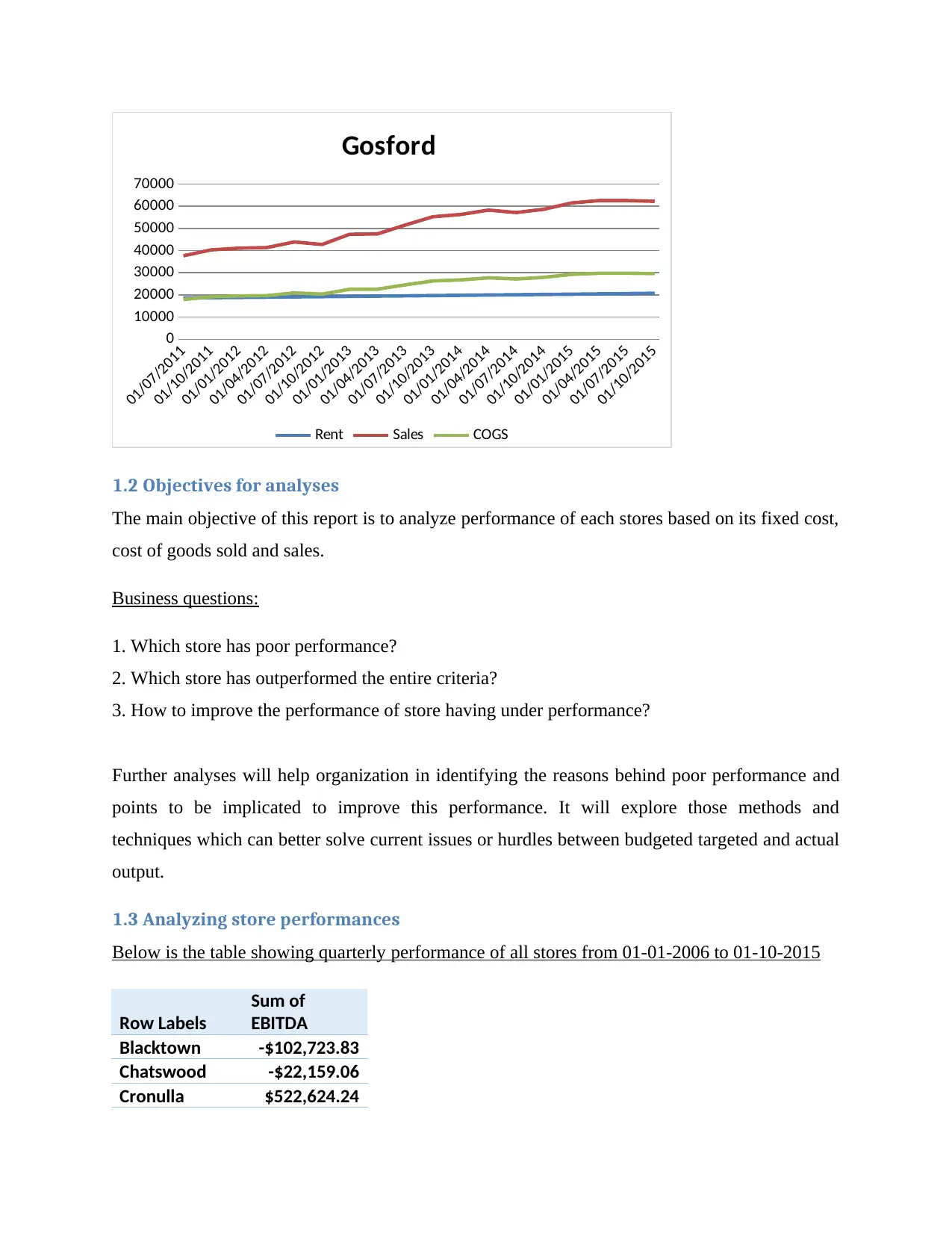
01/07/2011
01/10/2011
01/01/2012
01/04/2012
01/07/2012
01/10/2012
01/01/2013
01/04/2013
01/07/2013
01/10/2013
01/01/2014
01/04/2014
01/07/2014
01/10/2014
01/01/2015
01/04/2015
01/07/2015
01/10/2015
0
10000
20000
30000
40000
50000
60000
70000
Gosford
Rent Sales COGS
1.2 Objectives for analyses
The main objective of this report is to analyze performance of each stores based on its fixed cost,
cost of goods sold and sales.
Business questions:
1. Which store has poor performance?
2. Which store has outperformed the entire criteria?
3. How to improve the performance of store having under performance?
Further analyses will help organization in identifying the reasons behind poor performance and
points to be implicated to improve this performance. It will explore those methods and
techniques which can better solve current issues or hurdles between budgeted targeted and actual
output.
1.3 Analyzing store performances
Below is the table showing quarterly performance of all stores from 01-01-2006 to 01-10-2015
Row Labels
Sum of
EBITDA
Blacktown -$102,723.83
Chatswood -$22,159.06
Cronulla $522,624.24
01/10/2011
01/01/2012
01/04/2012
01/07/2012
01/10/2012
01/01/2013
01/04/2013
01/07/2013
01/10/2013
01/01/2014
01/04/2014
01/07/2014
01/10/2014
01/01/2015
01/04/2015
01/07/2015
01/10/2015
0
10000
20000
30000
40000
50000
60000
70000
Gosford
Rent Sales COGS
1.2 Objectives for analyses
The main objective of this report is to analyze performance of each stores based on its fixed cost,
cost of goods sold and sales.
Business questions:
1. Which store has poor performance?
2. Which store has outperformed the entire criteria?
3. How to improve the performance of store having under performance?
Further analyses will help organization in identifying the reasons behind poor performance and
points to be implicated to improve this performance. It will explore those methods and
techniques which can better solve current issues or hurdles between budgeted targeted and actual
output.
1.3 Analyzing store performances
Below is the table showing quarterly performance of all stores from 01-01-2006 to 01-10-2015
Row Labels
Sum of
EBITDA
Blacktown -$102,723.83
Chatswood -$22,159.06
Cronulla $522,624.24
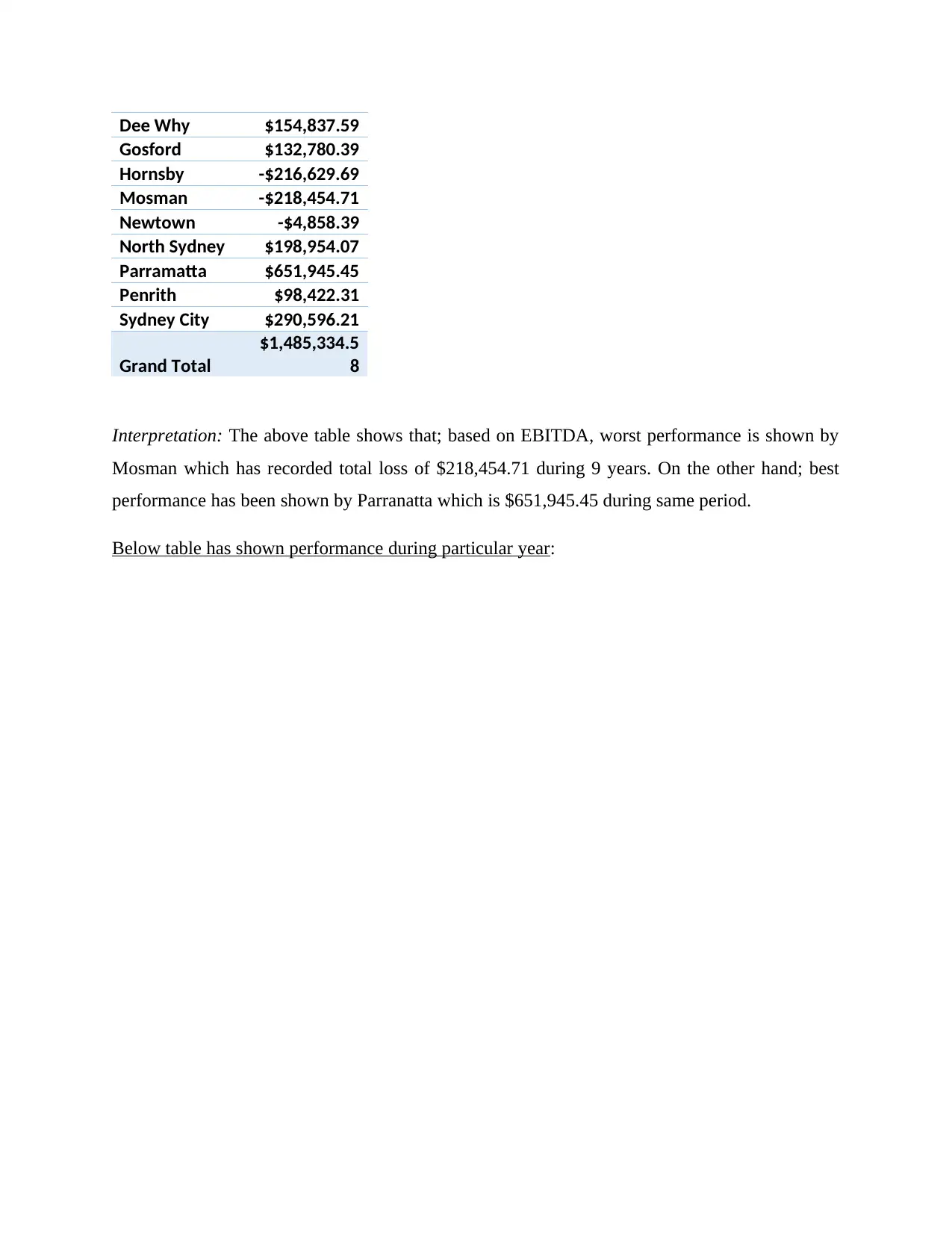
Dee Why $154,837.59
Gosford $132,780.39
Hornsby -$216,629.69
Mosman -$218,454.71
Newtown -$4,858.39
North Sydney $198,954.07
Parramatta $651,945.45
Penrith $98,422.31
Sydney City $290,596.21
Grand Total
$1,485,334.5
8
Interpretation: The above table shows that; based on EBITDA, worst performance is shown by
Mosman which has recorded total loss of $218,454.71 during 9 years. On the other hand; best
performance has been shown by Parranatta which is $651,945.45 during same period.
Below table has shown performance during particular year:
Gosford $132,780.39
Hornsby -$216,629.69
Mosman -$218,454.71
Newtown -$4,858.39
North Sydney $198,954.07
Parramatta $651,945.45
Penrith $98,422.31
Sydney City $290,596.21
Grand Total
$1,485,334.5
8
Interpretation: The above table shows that; based on EBITDA, worst performance is shown by
Mosman which has recorded total loss of $218,454.71 during 9 years. On the other hand; best
performance has been shown by Parranatta which is $651,945.45 during same period.
Below table has shown performance during particular year:
⊘ This is a preview!⊘
Do you want full access?
Subscribe today to unlock all pages.

Trusted by 1+ million students worldwide
1 out of 26
Related Documents
Your All-in-One AI-Powered Toolkit for Academic Success.
+13062052269
info@desklib.com
Available 24*7 on WhatsApp / Email
![[object Object]](/_next/static/media/star-bottom.7253800d.svg)
Unlock your academic potential
Copyright © 2020–2025 A2Z Services. All Rights Reserved. Developed and managed by ZUCOL.





